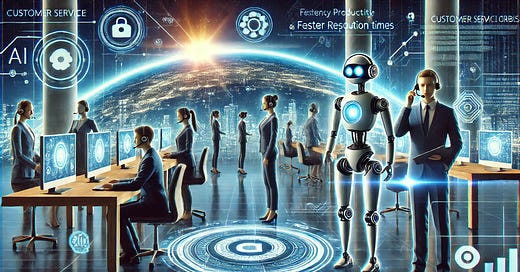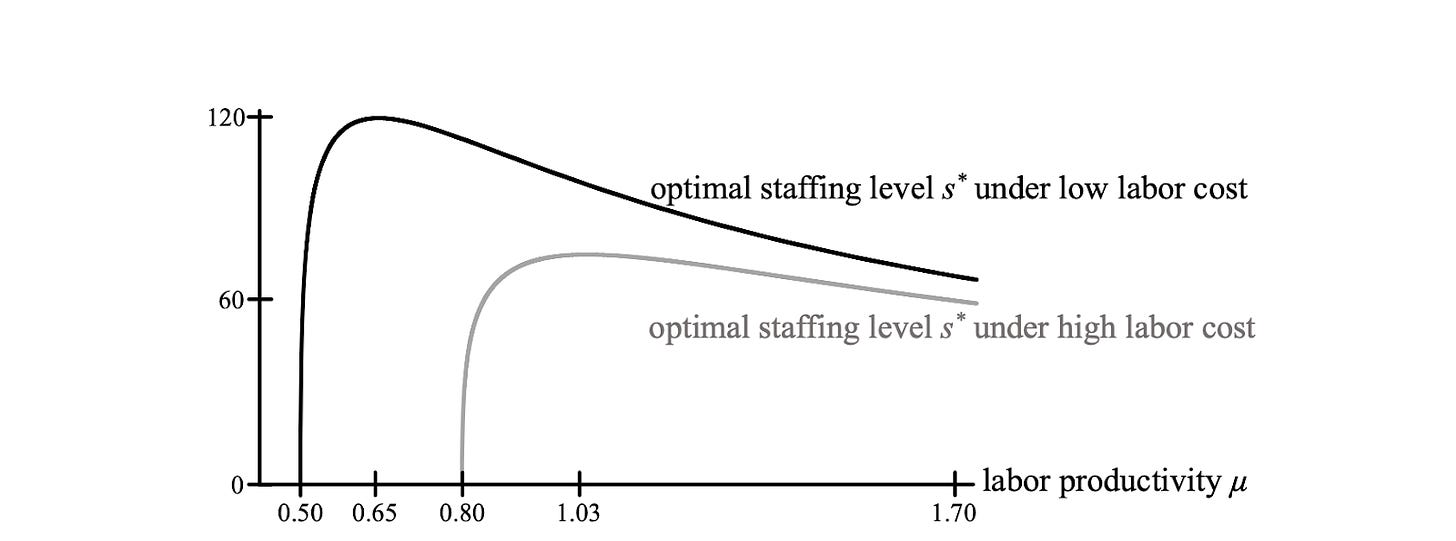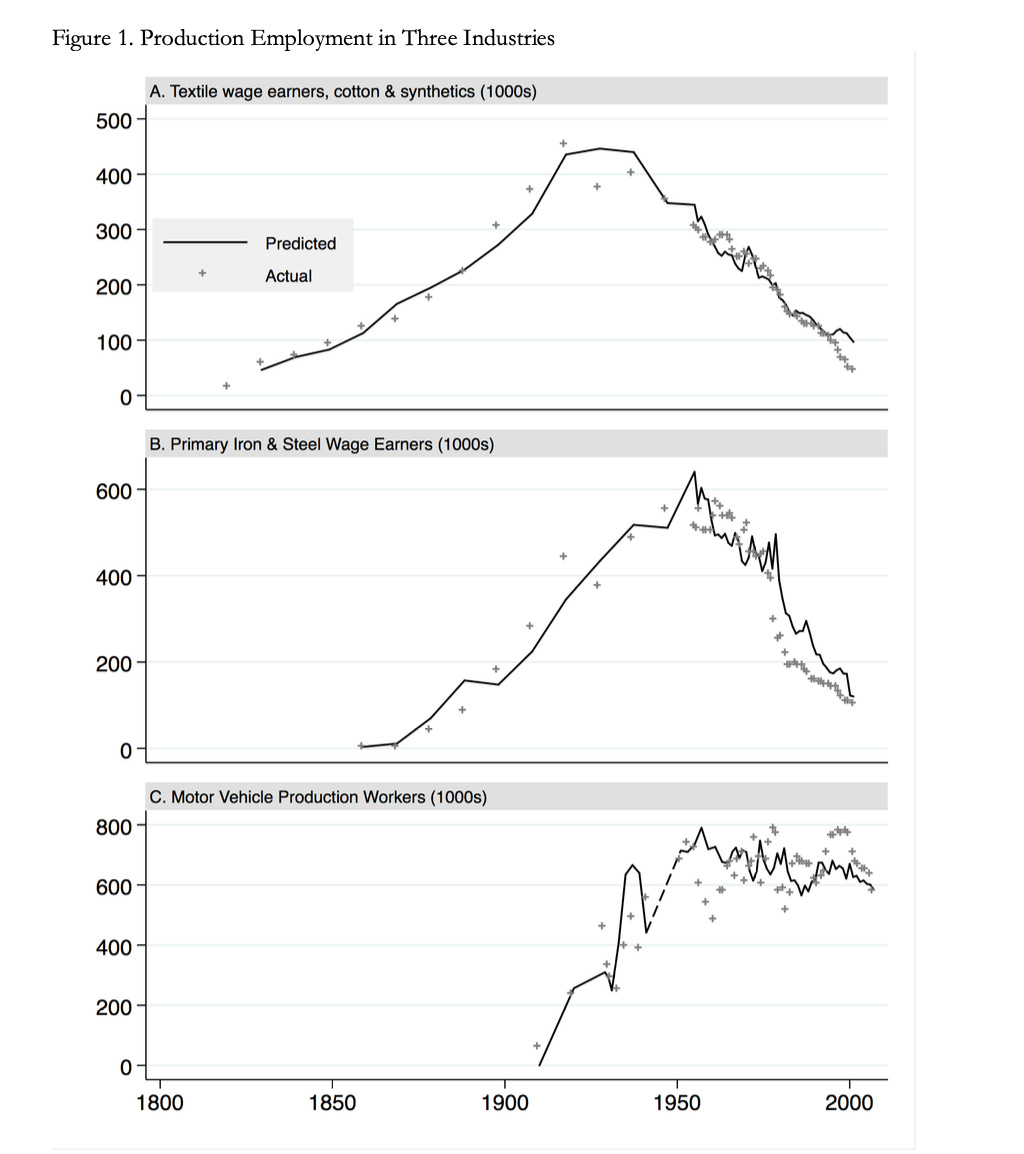Several months ago, Klarna, a ‘buy-now-pay-later’ firm, announced the global rollout of its AI assistant, powered by OpenAI.
Klarna’s AI assistant is designed to support the shopping and payment experience of its 150M customers and according to the firm, the assistant has already demonstrated a significant impact within just one month of operation. The key statistics from Klarna’s report highlight the assistant’s efficiency and effectiveness with approximately 2.3 million conversations managed, which accounts for two-thirds of Klarna’s customer service chats.
In short, the AI assistant performed the equivalent of 700 full-time agents!
And if you’re thinking: “But it probably didn’t do as well as human customer service representatives…”
The AI assistant matched human agents in customer satisfaction scores, reduced repeat inquiries by 25% due to higher accuracy in resolving issues, and reduced the average resolution time from 11 minutes to under 2 minutes.
So not only did it do as well, but it outperformed humans in certain aspects. Also, it’s available in 23 markets, 24/7, and supports over 35 languages.
According to the firm, Klarna’s profit is projected to improve by $40 million in 2024.
As many of you know, I’m somewhat skeptical when it comes to automation replacing humans.
Long-time readers know that one of my favorite books is The Goal, which begins with a manager meeting his former professor and enthusiastically telling him about implementing robots in his business. The professor is skeptical (as one may expect from an Israeli professor) and asks him three questions:
Did you sell more due to these robots?
Did you reduce the amount of inventory you carry?
Did you fire anyone?
The young manager’s answer to all the questions is a resounding “No,” so the professor goes on to finally question whether or not these robots really create value for the business.
The answer is once again, No…
But Gen AI has shifted the existing balance for many repetitive white-collar jobs.
Introducing AI technologies like Klarna’s assistant raises critical questions regarding the future of service jobs. A natural concern is whether AI will reduce the number of service jobs, as it can perform tasks traditionally done by humans more efficiently and at a lower cost.
However, the reality is more nuanced.
Given the current hallucinations of these large language models, I’m not sure that Gen AI solutions will interact directly with customers at scale and replace humans 100%; rather, they will enhance the productivity of existing customer service agents. So, instead of handling one customer every three minutes, an agent will handle 30 customers per minute by merely supervising the AI bots interacting with customers. This is already happening in customer support and software development with the use of co-pilots.
The question is, what will the impact on employment be?
Impact of Productivity on Capacity
I just returned from the MSOM conference (which can be considered the frontline of operations management research), where Terry Taylor (not this Terry Taylor) presented his paper on this precise topic.
His research delves into the impact of labor productivity on optimal staffing levels, abstracting from details on whether this productivity is gained by AI or other technology. However, the paper provides interesting insights into the dynamics of AI adoption in service settings. To explore this relationship, Taylor uses models within two canonical operations frameworks: newsvendor and queueing models.
You all know how fond I am of the newsvendor model, but the queueing model is better suited in this case, so let me describe it in more detail.
The paper’s queueing model is a mathematical representation of how customers (or tasks) arrive at a service facility, wait in line if necessary, and are served by available agents. The model is designed to capture the dynamics of service systems and how changes in labor productivity influence those dynamics.
The Key Components of the Model:
Arrival Rate (λ) represents the customers’ arrival rate at the service facility. It is assumed to follow a Poisson distribution, a common assumption in queueing theory due to its mathematical tractability and ability to account for random arrival patterns.
Service Rate (μ) denotes the rate at which service agents can complete tasks. In Taylor’s model, the service rate is directly influenced by labor productivity. As productivity increases, the service rate (μ) increases, meaning agents can serve more customers in a given period.
Number of Agents (n) is the number of service agents employed at the facility. The staffing level is a crucial decision variable in the model, as it determines the capacity of the service system.
Queue Length and Waiting Time are the metrics that capture the performance of the service system. Queue length refers to the number of customers waiting to be served while waiting time refers to the time a customer spends in the queue before being served.
Taylor’s model explores the trade-offs involved in staffing decisions, particularly how changes in productivity affect these trade-offs.
The key trade-offs include:
Cost of Labor vs. Service Quality: Increasing the number of agents (n) reduces waiting times and improves service quality but increases labor costs. Conversely, reducing the number of agents lowers costs but may lead to longer queues and waiting times, degrading service quality.
Productivity Gains vs. Staffing Levels: As productivity increases (higher μ), each agent can serve more customers, potentially reducing staffing levels without compromising service quality.
Optimal Staffing Level: The model aims to determine the optimal staffing level (n) that balances the cost of labor with the desired level of service quality. The optimal staffing level is influenced by both the arrival rate (λ) and the service rate (μ), which depends on productivity.
I will not derive the model here, but I will say that it’s simple and easy to follow.
Key Findings
Before I give the results away, try testing your intuition.
If agents become more productive, will the firm hire more or fewer agents?
Will firms hire more or fewer developers if software developers become more efficient?
The paper’s most important result concerns the tradeoff between Optimal Staffing Levels and Productivity: Taylor’s findings indicate that the optimal staffing level first increases and then decreases with labor productivity.
This counterintuitive result suggests that as productivity rises, firms may initially hire more staff to leverage the increased output per worker. However, beyond a certain point, further increases in productivity lead to a reduction in staffing levels.
The graphs depict staffing levels as a function of labor productivity. It’s evident that staffing levels begin to decline for very high labor productivity levels. Intuitively, most of us may anticipate this. For example, if agents are extremely fast and efficient, an employer may settle on having a single customer representative supervise all AI assistants.
The surprise is the left part of the graph.
Intuitively, as productivity increases, staffing levels also increase initially due to the elastic response of demand. Improved productivity means each agent can serve more customers in less time, making the service more efficient and attractive. This efficiency boost draws in new customers (previously deterred by the longer wait times), leading to increased demand. Firms must hire more staff to handle this surge in demand and maintain high service quality.
In this early phase of technology adoption, the marginal benefits of hiring more staff outweigh the marginal costs. Increased staffing helps manage the higher demand, reduces wait times, and maintains service quality, creating a positive feedback loop. Firms find it optimal to add more agents to capitalize on productivity gains and ensure smooth operations. This increasing trend continues until the market approaches saturation, where further productivity gains begin to lead to job reductions as demand becomes more inelastic. At this point, the labor-saving effects of automation start becoming more pronounced.
It’s also interesting to observe the range of productivity values for which optimal staffing increases expand when service economics become less favorable (e.g., lower service fees or higher labor costs). This implies that firms are more likely to hire additional staff in less profitable service environments to maximize productivity gains.
The model indicates that productivity gains can lead to increased employment in service industries with elastic demand. However, further productivity improvements lead to job reductions as demand becomes saturated. So, industries with customers who are willing to pay for a faster service will see employment gains (and indeed, Amazon and Walmart continue hiring at a fast pace). In contrast, industries whose customers are indifferent to speed will see fewer gains, if any.
Historical Perspective
This result is not unique to AI or to service industries.
James Bessen’s paper, “Automation and Jobs: When Technology Boosts Employment,” provides a comprehensive analysis of how automation impacts employment across different industries. The study investigates the conditions under which technological advancements can lead to job growth rather than job decline, challenging the commonly held belief that automation will ultimately lead to fewer jobs.
Bessen’s analysis reveals a similar inverted U-shaped pattern in employment across several industries, including textiles, steel, and automotive manufacturing. Initially, these industries experienced job growth alongside productivity gains. However, over time, as markets became saturated and demand elasticity decreased, employment began to decline despite continued productivity improvements:
Bessen introduces a much more complex model than Taylor’s, combining industry-specific productivity growth with general income growth to explain these employment patterns.
Similarly, the research highlights that demand-price elasticity is critical in determining whether automation will increase or decrease employment.
Impact on Software Engineers
As the director of the Management and Technology program at the University of Pennsylvania, I’m often asked whether students should continue to study computer science since Gen-AI is clearly going to disrupt the profession.
AI tools can automate many aspects of coding, testing, and maintenance, potentially reducing the need for human developers. However, AI also creates new opportunities for software development, particularly in developing and maintaining AI systems. Moreover, as AI becomes more integrated into various industries, the demand for software developers with expertise in AI and machine learning will likely rise.
Individual developers can become significantly more productive as AI and automation technologies are integrated into software development processes. Tools that automate coding, testing, and maintenance tasks allow developers to complete projects faster and with fewer errors. This increased productivity means that each developer can handle more work, theoretically reducing the need for a large workforce.
However, as in Taylor’s model, where increased productivity initially leads to higher staffing levels due to elastic demand, the software development industry may experience a similar phase. Productivity enhancements can make software development more efficient and accessible, leading to a surge in demand for software products and services. Companies may need to hire more developers to meet this increased demand, particularly to handle the more complex and creative aspects of development that AI cannot easily automate.
James Bessen’s research on automation and employment provides a broader context for understanding the impact of AI on software developers. Bessen’s model shows that the effect of automation on employment depends significantly on the elasticity of demand for the products or services. In industries where demand is highly elastic, productivity gains can lead to increased employment. This principle applies to the software development sector, where demand for new software, applications, and technological innovations is often highly elastic.
As AI tools improve software developers’ productivity, lowered costs and faster development times can stimulate demand for new, more advanced software solutions.
It’s not hard to imagine how many areas of our lives could improve if it were easier to launch new ideas that require substantial coding and data analysis. Such developments can significantly boost the entire area of life sciences and drug development, for example. Businesses may seek to implement more sophisticated systems, develop new applications, and explore innovative technologies, driving demand for skilled developers who can design and oversee these complex projects.
As companies expand their teams to capitalize on new market opportunities, the major gains from automation and AI will be realized and the initial surge in demand will be met. At this point, companies will have optimized their operations and will require fewer developers to maintain and update existing systems since the market will become saturated and demand may become more inelastic.
Like the patterns observed in Taylor’s and Bessen’s models, which suggest that the impact is not static, the industry could see a shift where further productivity improvements lead to job reductions rather than increases. However, this doesn’t mean the end of opportunities for developers; rather, the nature of the job may evolve, with a greater focus on overseeing AI systems, innovating new technologies, and integrating complex systems across various platforms.
Bottom Line
Adopting AI technologies like Klarna’s assistant highlights AI’s impact on service jobs.
Terry Taylor and James Bessen’s research provides a nuanced understanding of the impact of AI and automation on employment. While the possibility for job reduction is real in certain scenarios, the overall impact on employment will depend on various factors, including demand elasticity and industry-specific characteristics.
For service jobs and software development, AI could possibly lead to job displacement, but also to the creation of new opportunities, highlighting the need for adaptable strategies in managing the workforce transition in the age of AI.
As a professor, should I be worried about AI taking over?
Well, if an AI assistant could teach my classes, grade papers, and attend faculty meetings, maybe I’d finally have time to finish writing my book!






The interesting thing about customer service jobs is that people in those roles are almost always given a very strict procedure to handling any kind of inquiry. In a way, companies require people in customer support to act like software. Humans are not going to be better robots than robots.
I think there's a potential opportunity to do the exact opposite. Have human customer support agents and give them more agency to make decisions. Change up the job title. When I think about it, most bankers, account managers, and brokers of all types are a sort of customer support. They're just paid better and valued for their judgement (which AI is less good at). Doing something similar in all customer service jobs could result in much happier customers and increased revenue.